At CarnivoreWeb.com, we independently review products and outfitters. However, we may earn a commission when you purchase products through links on our site. Read our affiliate policy. Read about how we test products.
From Bushcraft to Hunting, Here are Three Top Folding Saws That May Have a Place in Your Outdoor Kit.
On any outdoor adventure, having the right kit is important. Hunting is no exception. We might not be planning on doing any bushcraft chores, but a folding saw always serves a person well in the woods. Every year you go hunting, Mother Nature seems intent on crowding shooting lanes with new branches or trying to conceal stands with more vegetation than is useful. A good saw helps keep your line of sight and shooting lane clear.
In this article, we look over a few of the newest folding saws, which are easy to pack in along with your other gear. The folding saw is one of those highly unappreciated tools that an outdoorsman’s kit should have.
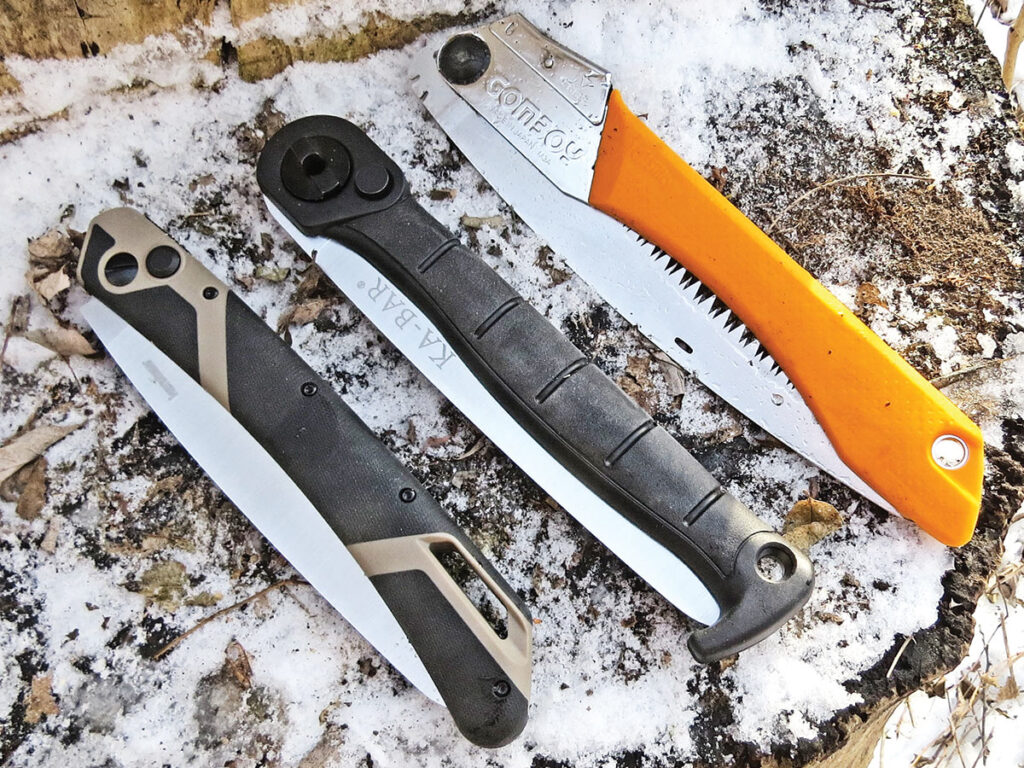
When talking saws, we need to understand the nomenclature. First, there’s the direction of cut. They’re normally either a push-cut saw or a pull-cut saw. In other words, the saw cuts either on the pull stroke or the push stroke of your cycle. Pitch or teeth per inch (TPI) is the number of tips of teeth on 1 inch of the saw blade. The term “kerf” describes the width of the groove that a saw’s cutting action leaves in the material. Teeth on a saw blade are positioned off center in an alternating pattern; this is called “set.” The width of this set creates the size of the kerf. It’s necessary to have a set to your teeth to create a kerf wider than the body of the blade. This makes the saw cut more efficiently and prevents binding.
To be efficient in your cutting, you must learn to use as much as of the blade as possible during the cutting stroke; you must also let up on the downward pressure while on the return stroke. A return stroke isn’t supposed to cut, as it’s more useful in cleaning out the kerf of the sawdust. Also, the teeth aren’t designed to cut in that direction. Don’t put too much downward force during the cutting stroke — let the saw do the work. Finally, make sure there’s nothing pressing the material together during the cut, as it’ll pinch the blade, seizing it up in the cut. Follow those basics, and you’ll be on your way to cutting mastery.
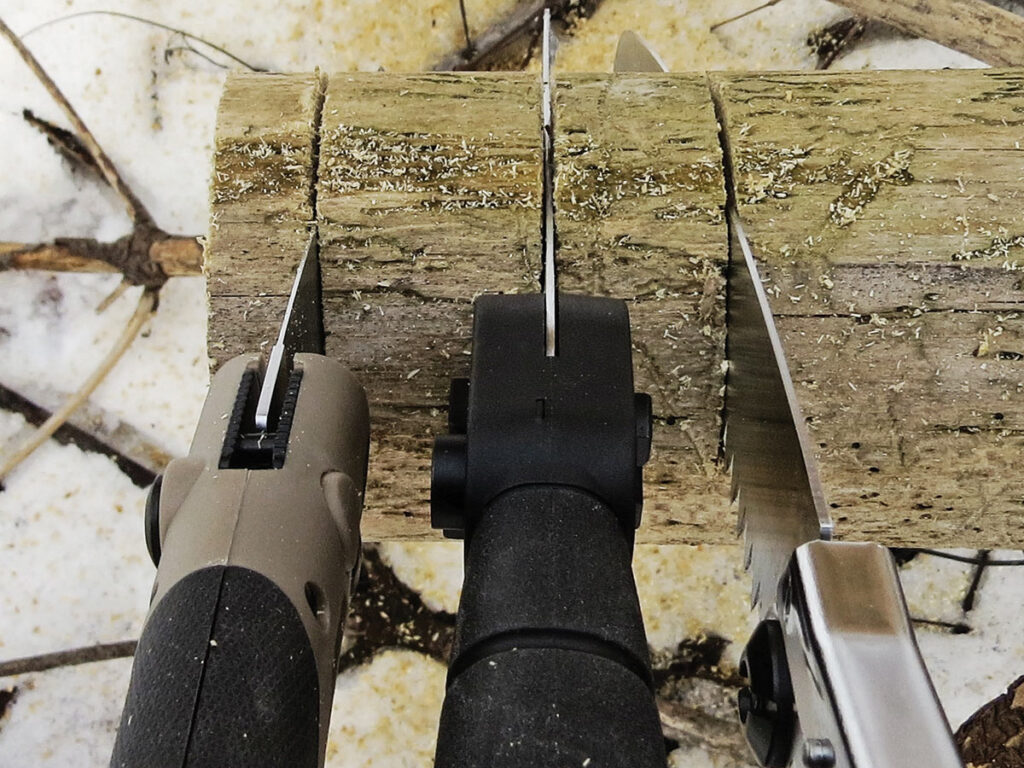
Here’s a few parting tips as well. One, get a good footing before you cut. Two, don’t stand directly behind your saw — stand a bit to the side so your elbow won’t bang into your body. Lastly, keep a bit of paraffin wax on you to help lubricate and protect your blade.
Top Folding Saws
KA-BAR Folding Saw
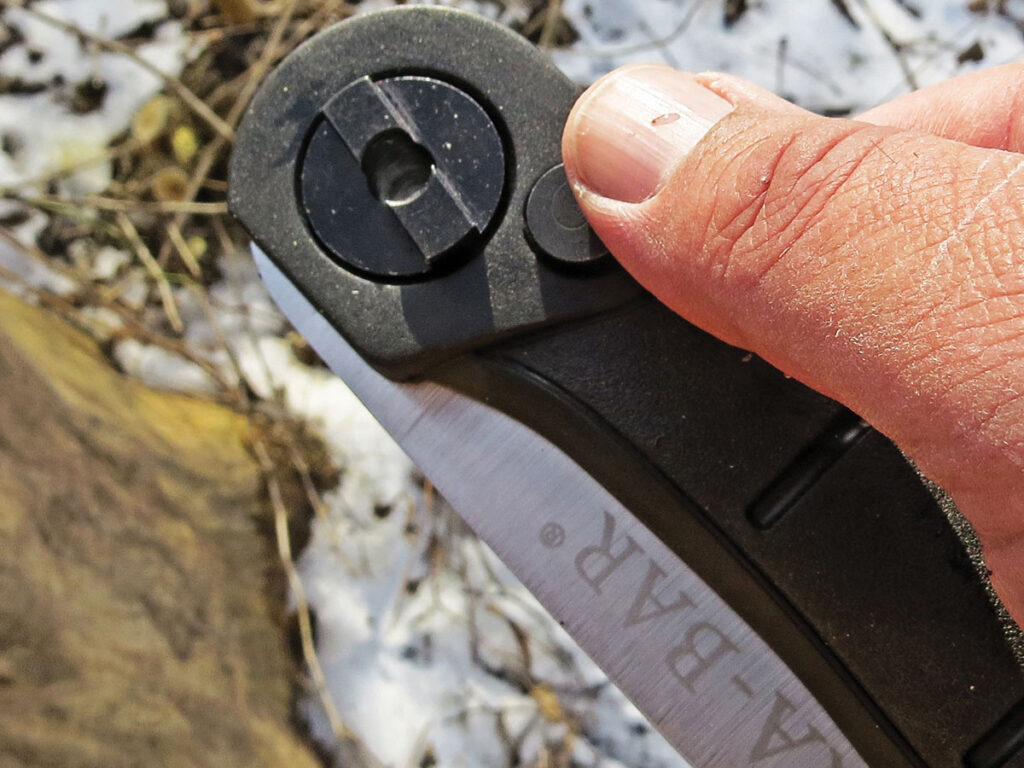
Open length: 17.5 inches
Closed length: 9.75 inches
Blade length: 7.75 inches
Cutting Edge: 6.5 inches
MSRP: $44
URL: kabar.com
KA-BAR is known for their outdoor line, so it’s reasonable to expect they’d produce a folding saw at some point. At first unboxing, the saw looked good. As we examined it closer, we noticed burrs from the tooth-grinding process hadn’t been cleaned off. We also noticed the set of the teeth was quite wide, more than normal. Given these two issues, we were curious to see how it would perform. The blade locks into place in both the open and closed position. To lock and unlock the blade, simply press the button up by the pivot point. The button is in a good spot, still accessible to your thumb, but doesn’t get in the way of your grip. It’s a pull-cut tooth pattern with a wide set, and the rake of the teeth is negative. A negative rake means the tooth leans back from center. A negative rake can make cutting a little easier on the user, as they don’t encounter as much resistance as with a positive rake (forward leaning). The cutting edge is curved, which can also make the cutting flow easier.
Right off the bat, our biggest pet peeve with this saw is that they put a finger choil on the blade, needlessly wasting space. You might think you don’t normally cut back there, but you can start back there — every tooth counts on a hand-powered saw. For the tooth count on the KA-BAR, it’s an aggressive six teeth per inch. When folded it makes a nice, neat package for stowing away in a pack at a maximum width of only 1.75 inches. Handle construction is a textured rubber overmold in a ribbed pattern, with a palm swell area to aid your grip.
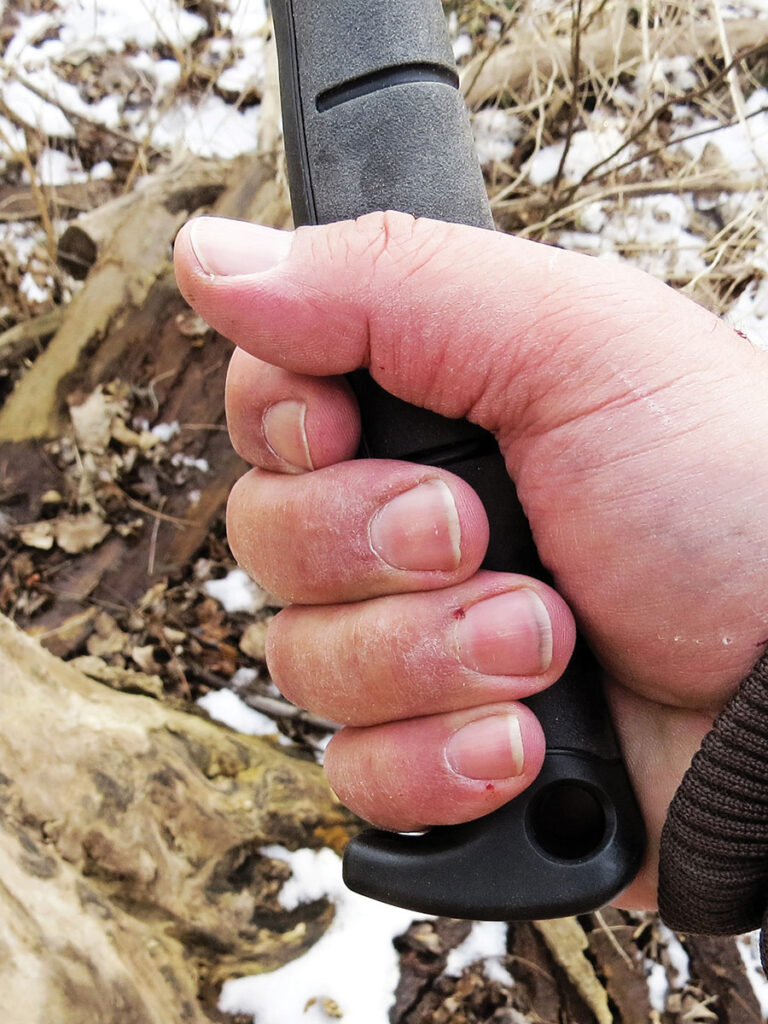
As for its cutting ability, we were surprised looking at the width of the kerf and the quality of the tooth grind. We thought this saw would be a bit of a dog on the cut, requiring a lot of effort, but it wasn’t. It performed well — not a fast-cutting saw, but not slow either. The wide kerf picked up dust, which means you might have to give the saw a tap once in a while to clear it off. Due to the KA-BAR’s size, we’d want to take full advantage of the available blade length and think of it as a saw for active carry instead of long-term storage in a kit. Made in China.
Kershaw Taskmaster 2
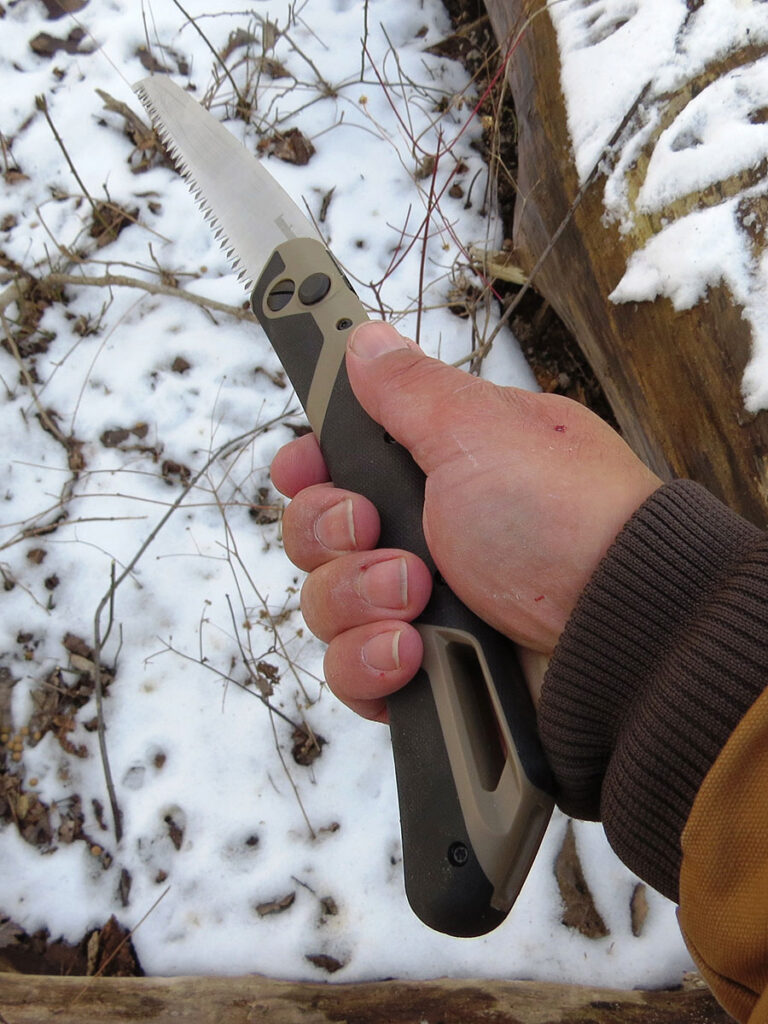
Open length: 15.75 inches
Closed length: 9.125 inches
Blade length: 7 inches
MSRP: $54
URL: kershaw.kaiusa.com
The grip on the Taskmaster 2 is a dual textured grip with textured rubber inlays over molded plastic. At the back of the handle is a lanyard slot. To lock the blade open and closed Kershaw uses a button lock placed neatly out of the way, while still being accessible. The overall profile is nice and tidy, making it easy to tuck in a pack or bag for a car kit. Kershaw also put a negative-raked tooth pattern on their pull-style cutting blade. Tooth count of the Taskmaster 2 is seven teeth per inch. The set on the Taskmaster 2 creates thin kerf. As with the KA-BAR, we found that the grind on the teeth wasn’t clean.
You might wonder what the big deal is with having burrs on the teeth. Burrs are basically wires hanging on the edge. If the wire isn’t removed, it can press against your edge during the cutting process, causing it to dull. Also, the size of the burrs gives you an indication of how hard the steel is. Soft steel will usually produce larger ribbon-like burrs. Kershaw lists the materials as a high carbon steel with nickel plating “for extra protection.” This may refer to rust resistance. We’ve noticed both the KA-BAR and the Kershaw don’t have induction-hardened teeth, which will affect the durability of the teeth but makes it possible to resharpen.
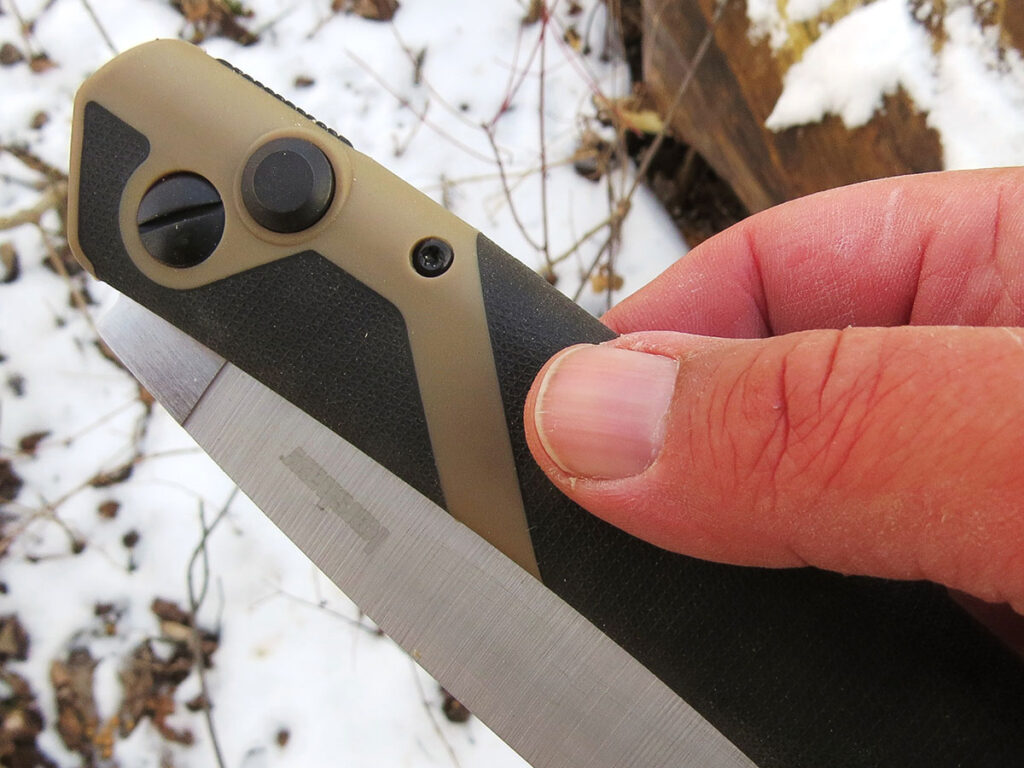
Compared to the KA-BAR, the Taskmaster is very light. Among the three, the Kershaw had the shortest blade. Even so, it performed like a champ with clean, well-paced cuts. Inch for inch, it cut more efficiently than the KA-BAR. Belt carry would enable you to access it quickly. It’s a great saw for an outdoor or emergency kit due to its size, and its price won’t break the bank either. Made in China.
Silky Gomboy 240
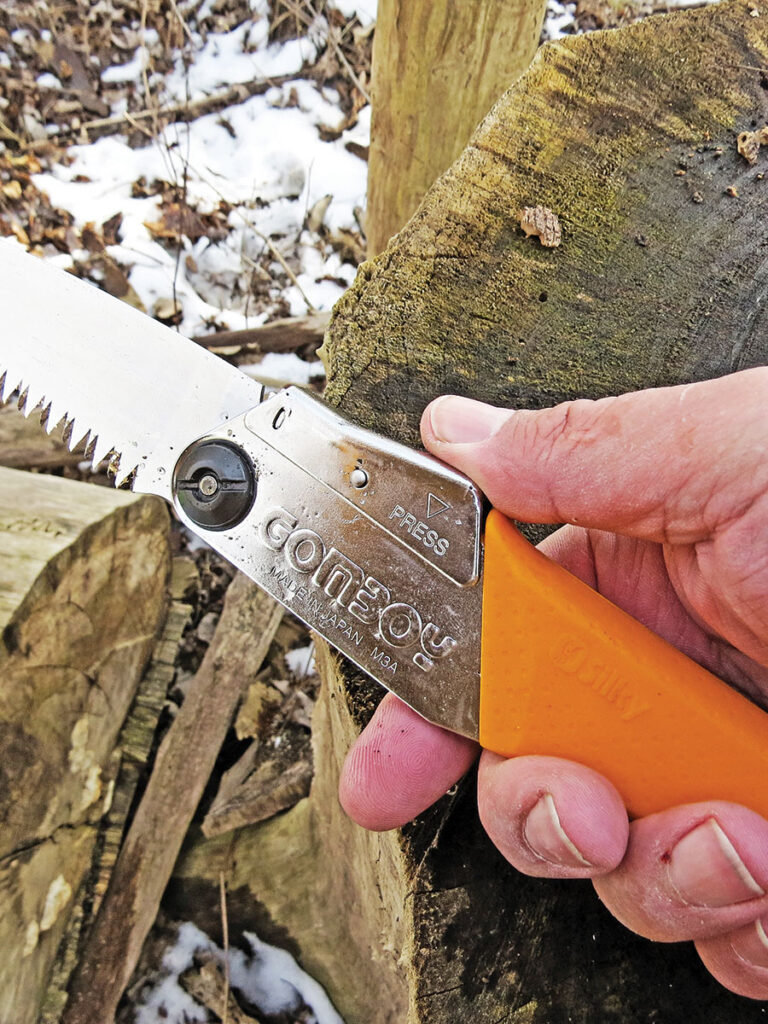
Open length: 19.75 inches
Closed length: 10.6 inches
Blade length: 9.43 inches
MSRP: $43 to $53
URL: silkysaws.com
Silky has a reputable name, not only among the bushcraft crowd, but also because their main focus is providing tools for arborists. The Gomboy is the only saw in the group that comes with a case. As much as this is a nice addition and will work well for storage in a bag, it’s a bit too rigid to carry it. A soft belt carry case would’ve been more practical. Another downside of the case is that, even though it has drain holes, it still holds some moisture. The Gomboy is available in a variety of colors. The Gomboy has a large tooth pattern with a seven TPI count. Silky actually lists it as 6.5 TPI due to the metric system. Silky’s use of a curved cutting edge on the Gomboy extends the actual length and creates a cutting advantage by changing the angle of approach. Overall, the cutting edge is 9 inches long.
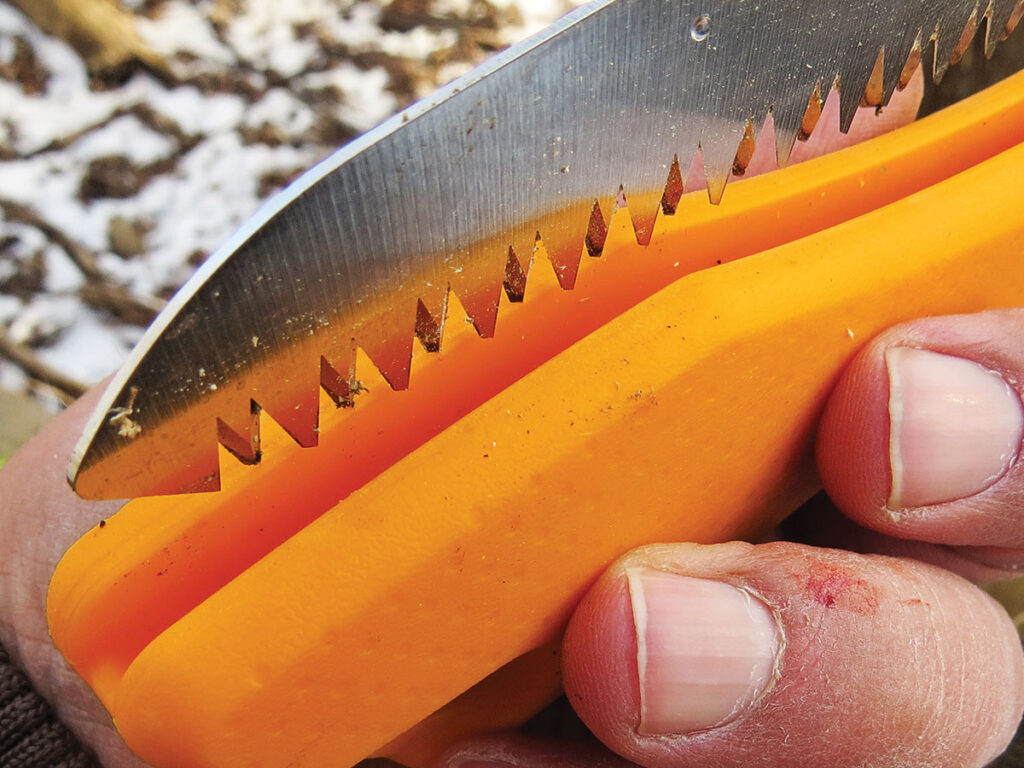
To lock the blade in place, Silky uses a spring-loaded locking lever, which is quick and easy. Out of this group of saws, the pivot point on the Gomboy was the stiffest. It’s also the widest of the saws when closed, measuring 2.43 inches at its widest point. Some older Silky models have a rubber handle with a set of steel liners in the handle. The Gomboy 240 has a rubber handle with a steel spine, giving the sides of the handle a little flexibility.
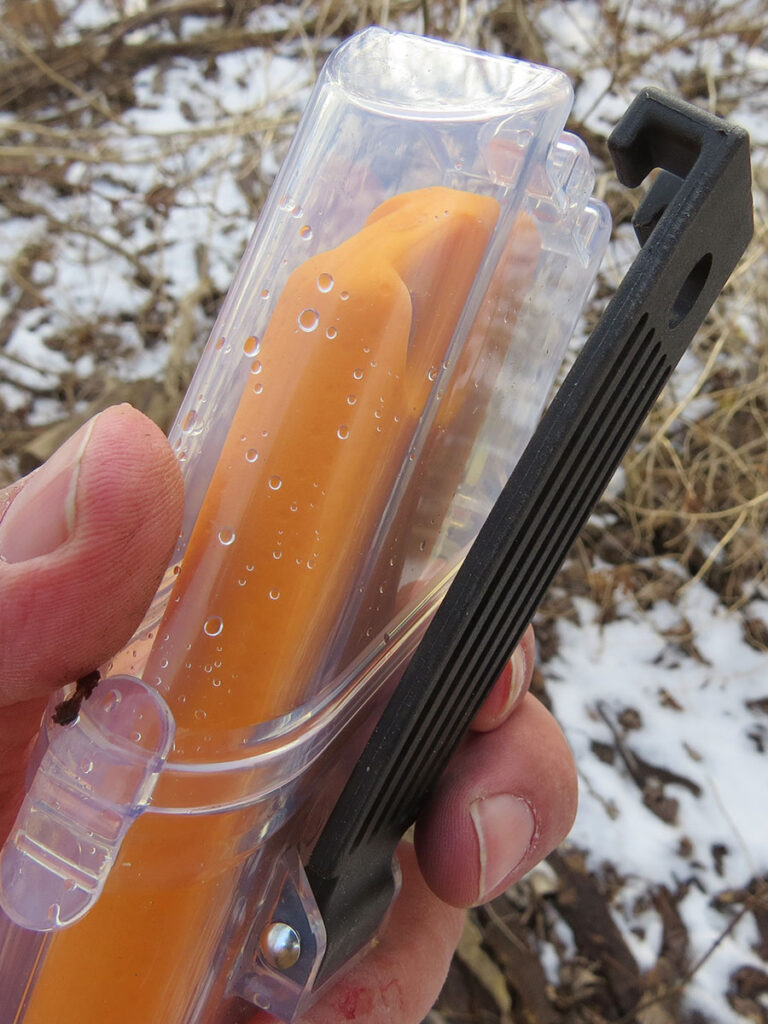
While testing these saws in Canada in January, the rubber really didn’t flex much. The lanyard hole is lined with a metal ring embedded in the rubber. All in all, the handle is comfortable. As for performance, this saw is a regular piranha. It has the longest blade length, helping cutting speed. Inch for inch, it was a race car. Silky makes an excellent product. This would be a great bushcraft saw, but it’ll likely get loads of use trimming those ever-growing maple trees in Canadian backyards. Made in Japan.
3 Folding Saw Safety Tips
When using a folding saw:
- Get a good footing before you cut;
- Don’t stand directly behind your saw. Instead, stand a bit to the side as to allow your elbow not to bang up against your body; and;
- Keep a bit of paraffin wax handy to help lubricate and protect your saw. Besides, paraffin wax has multiple uses.
Editor’s Note: This article originally appeared in Carnivore Magazine Issue 8.
More Knives & Blades
- Top General-Purpose Fixed Blades
- Fold Rush!: Top Folding Saws
- Osprey Knives Review: K2 Raptor & Warthog Field Tested
- Japanese Kitchen Knife Basics
- Get Sharp: Work Sharp’s Ken Onion Edition Knife & Tool Sharpener Mk.2
Why You Can Trust CARNIVORE
Since its launch, CarnivoreWeb.com has been a trusted authority on hunting, fishing and wild food, delivering expert insight for outdoorsmen who live the field-to-table lifestyle. More than a hunting and fishing site, CarnivoreWeb.com covers the full spectrum of the modern outdoors—from rifles, bows, and fishing gear to cooking, conservation and adventure.
Our contributors are drawn from across the hunting and angling world, including seasoned guides, lifelong hunters, competitive shooters and outdoor writers with decades of field experience. Every review, article and feature is built on firsthand testing, deep research, and an unwavering commitment to accuracy.
Commitment to Journalistic Principles
At CarnivoreWeb.com, upholding journalistic integrity is our top priority. We follow strict editorial standards to ensure all content is accurate, transparent, and unbiased. Our editors and writers operate independently, free from outside influence, advertisers or stakeholders. We adhere to established journalistic codes of ethics, holding ourselves accountable for the information we publish, correcting errors when they occur and disclosing any potential conflicts of interest.
This commitment ensures that our readers can trust CarnivoreWeb.com to provide reliable, honest coverage that helps them make informed decisions—whether selecting gear, honing outdoor skills or preparing wild game.
Find out more about our Editorial Standards and Evaluation Process


